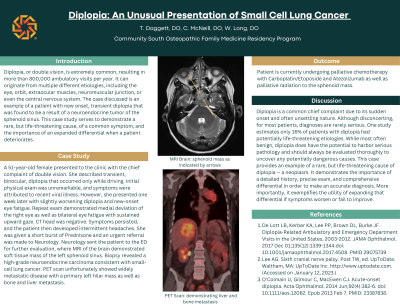Back

Clinical: General Topics
DIPLOPIA: An Uncommon Presentation for Small Cell Lung Cancer
Friday, March 31, 2023
12:00 PM East Coast USA Time

- TD
Taylor A. Daggett, DO (she/her/hers)
Osteopathic Family Medicine Resident Physician
Community Health Network
Westfield, Indiana, United States
Presenting Author(s)
Introduction: Diplopia, or double vision, is extremely common, resulting in more than 800,000 ambulatory visits per year1. It can originate from multiple different etiologies, including the eye, orbit, extraocular muscles, neuromuscular junction, or even the central nervous system. The case discussed is an example of a patient with new onset, transient diplopia that was found to be a result of a neuroendocrine tumor of the sphenoid sinus. This case study serves to demonstrate a rare, but life-threatening cause, of a common symptom, and the importance of an expanded differential when a patient deteriorates or fails to improve.
Case Study: A 51-year-old female presented to the clinic with the chief complaint of double vision. She described transient, binocular, diplopia that occurred only while driving. Initial physical exam was unremarkable, and symptoms were attributed to recent viral illness. However, she presented one week later with slightly worsening diplopia and new-onset eye fatigue. Repeat exam demonstrated medial deviation of the right eye as well as bilateral eye fatigue with sustained upward gaze. CT head was negative. Symptoms persisted, and the patient then developed intermittent headaches. She was given a short burst of Prednisone and an urgent referral was made to Neurology. Neurology sent the patient to the ED for further evaluation, where MRI of the brain demonstrated soft tissue mass of the left sphenoid sinus. Biopsy revealed a high-grade neuroendocrine carcinoma consistent with small-cell lung cancer. PET scan unfortunately showed widely metastatic disease with a primary left hilar mass as well as bone and liver metastasis. She is now undergoing palliative chemo-immuno-therapy and radiation.
Discussion: Diplopia is a common chief complaint due to its sudden onset and often unsettling nature. Although disconcerting, for most patients, diagnoses are rarely serious. One study estimates only 16% of patients with diplopia had potentially life-threatening etiologies2. While most often benign, diplopia does have the potential to harbor serious pathology and should always be evaluated thoroughly to uncover any potentially dangerous causes. This case provides an example of a rare, but life-threatening cause of diplopia – a neoplasm. It demonstrates the importance of a detailed history, precise exam, and comprehensive differential in order to make an accurate diagnosis. More importantly, it exemplifies the utility of expanding that differential if symptoms worsen or fail to improve.
Case Study: A 51-year-old female presented to the clinic with the chief complaint of double vision. She described transient, binocular, diplopia that occurred only while driving. Initial physical exam was unremarkable, and symptoms were attributed to recent viral illness. However, she presented one week later with slightly worsening diplopia and new-onset eye fatigue. Repeat exam demonstrated medial deviation of the right eye as well as bilateral eye fatigue with sustained upward gaze. CT head was negative. Symptoms persisted, and the patient then developed intermittent headaches. She was given a short burst of Prednisone and an urgent referral was made to Neurology. Neurology sent the patient to the ED for further evaluation, where MRI of the brain demonstrated soft tissue mass of the left sphenoid sinus. Biopsy revealed a high-grade neuroendocrine carcinoma consistent with small-cell lung cancer. PET scan unfortunately showed widely metastatic disease with a primary left hilar mass as well as bone and liver metastasis. She is now undergoing palliative chemo-immuno-therapy and radiation.
Discussion: Diplopia is a common chief complaint due to its sudden onset and often unsettling nature. Although disconcerting, for most patients, diagnoses are rarely serious. One study estimates only 16% of patients with diplopia had potentially life-threatening etiologies2. While most often benign, diplopia does have the potential to harbor serious pathology and should always be evaluated thoroughly to uncover any potentially dangerous causes. This case provides an example of a rare, but life-threatening cause of diplopia – a neoplasm. It demonstrates the importance of a detailed history, precise exam, and comprehensive differential in order to make an accurate diagnosis. More importantly, it exemplifies the utility of expanding that differential if symptoms worsen or fail to improve.
